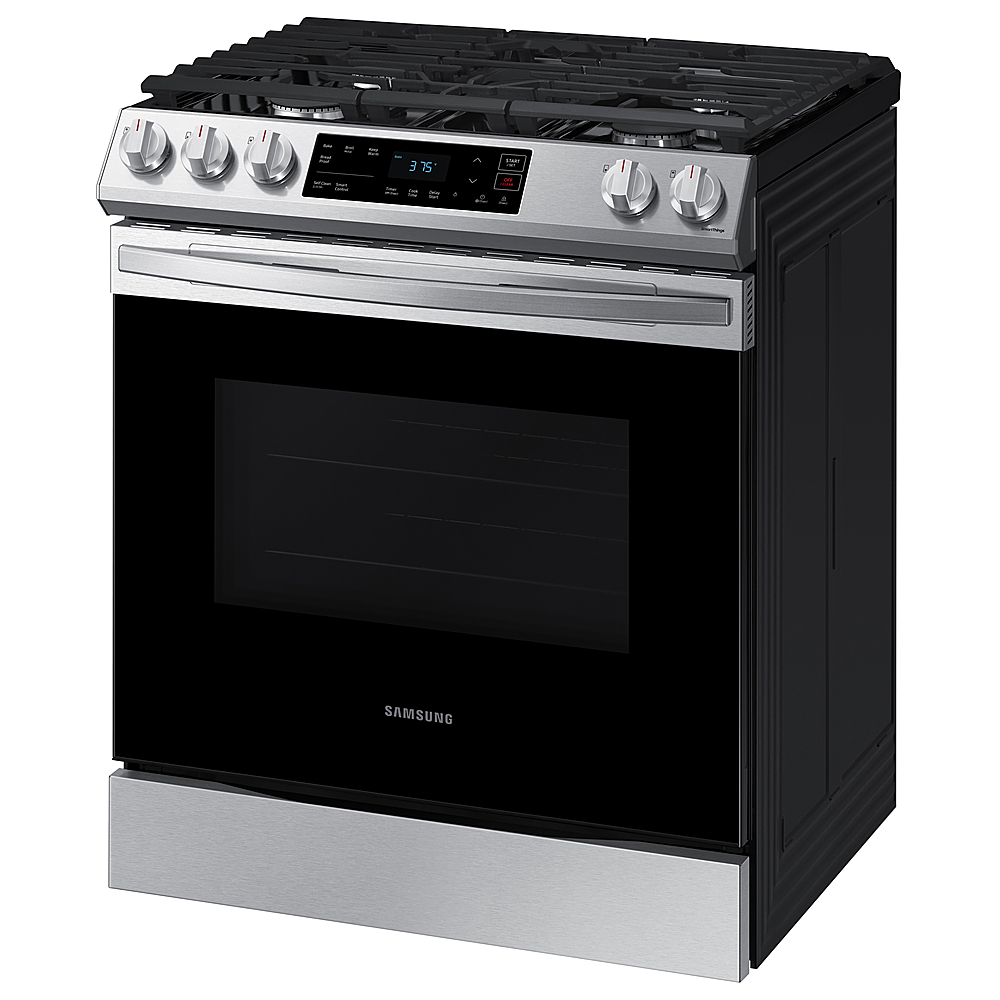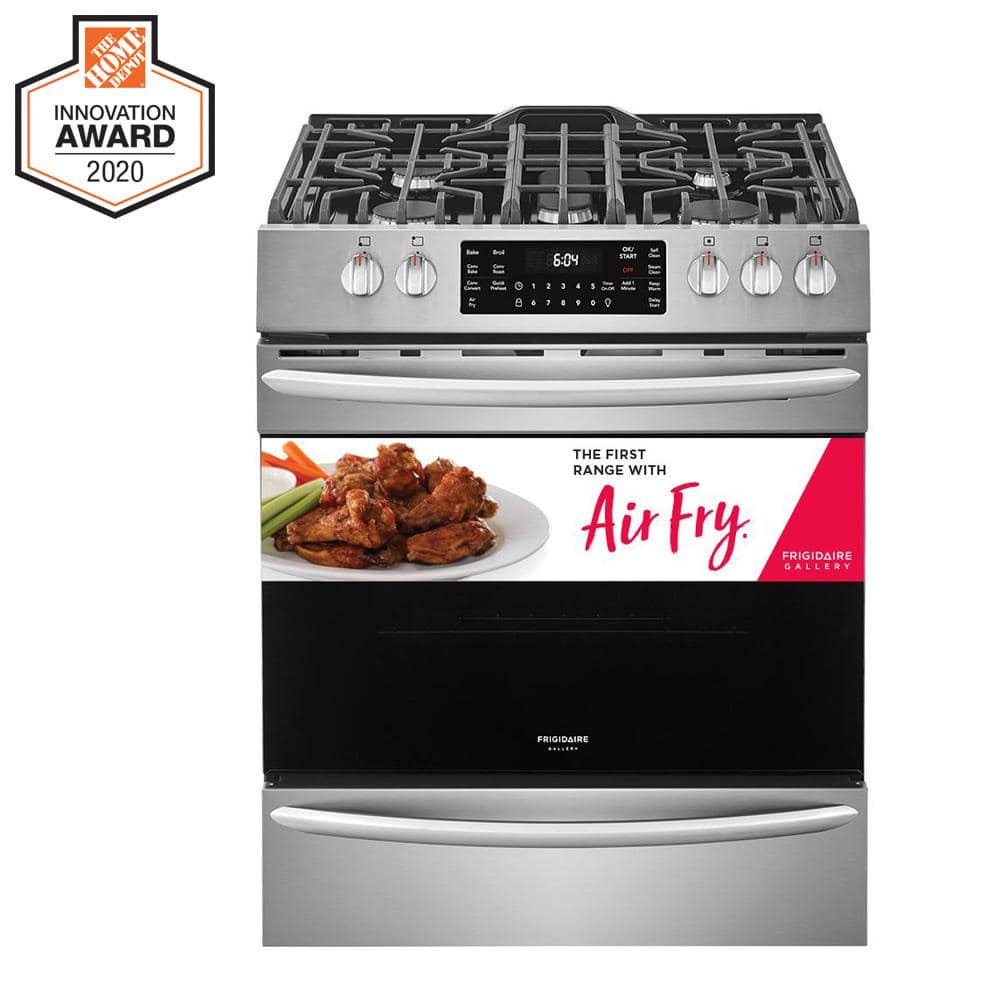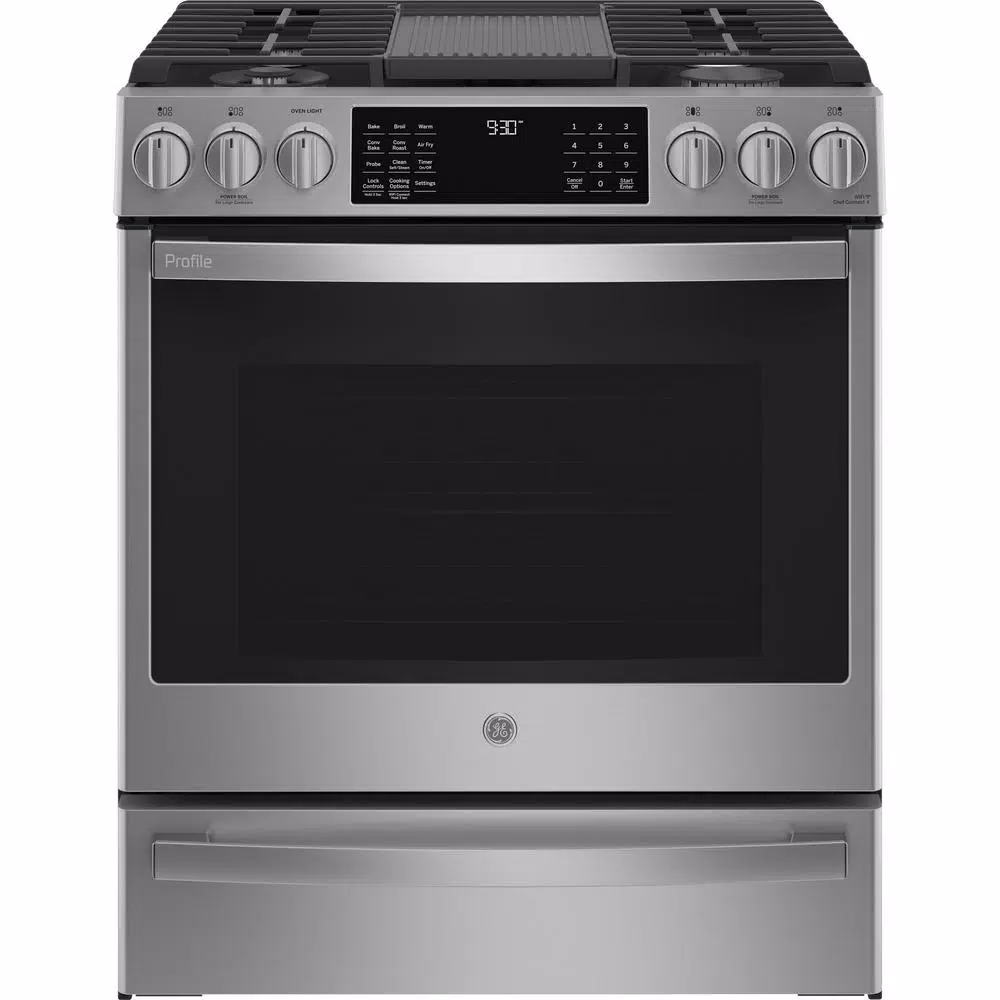Samsung – 6.0 cu. ft. Front Control Slide-in Gas Range with Wi-Fi – Fingerprint Resistant Stainless Steel
-
( 8 Reviews )Rated 4.50 out of 5 based on 8 customer ratings08
The Samsung Front Control Slide-in Gas Range is fully Wi-Fi connected and voice enabled, making it easy to create delicious meals for your family.
-
GE 5.3 cu. ft. Slide-In Gas Range with Steam-Cleaning Oven in Stainless Steel
Rated 4.56 out of 509GE 5.3 cu. ft. Slide-In Gas Range with Steam-Cleaning Oven in Stainless Steel
Rated 4.56 out of 509
Ready2Fit™ guarantee
If your Samsung front control slide-in range doesn’t fit your 30″ freestanding range cutout, enjoy $100* on us to cover any countertop modification costs.1
Fingerprint Resistant Finish
Fingerprint resistant, for an everyday beautiful finish.
Flexible Cooktop
Get to high heat quickly for searing meat or boiling water, or turn down to a simmer to make your favorite sauces. Easily slide your pots and pans across the seamless, edge-to-edge grates covering a 5 burner cooktop.
2 Power Burners
Quickly boil water for soups or pasta with the 2 power burners.
Large Oven Capacity
This large 6.0 cu. ft. oven fits multiple meals at one time, or it can easily accommodate big casserole dishes or roasting pans.
Wi-Fi Connectivity
Monitor and adjust cook time and temperature of your oven, right from your smartphone through the SmartThings™ App.2
Voice-Enabled
Control your oven by voice when you’re busy doing other things by using your favorite virtual assistant, whether it’s Bixby, Alexa or Google.3
Glass Touch Controls
Glass Touch Controls offer a premium design that is easy to use and clean
Self Clean
Get help from your oven with Self Clean. The self cleaning system deep cleans by heating to a high temperature to burn off grease and food residue.
1Visit samsungpromotions.com/SlideInReady2Fit for details.
2Available on Android and iOS devices. A Wi-Fi connection and a Samsung account are required.
3A Wi-Fi connection and a Samsung account are required. Bixby is Samsung’s brand of artificial intelligence (AI)/Internet of Things (IoT) voice assistant. Voice commands are available on Android and iOS devices.
Additional information
| Product Depth x Height x Width (in.) | 28 11/16 x 36 1/4 x 29 15/16 |
|---|---|
| Depth Without Handle | 26 7/16 inches |
| Depth With Handle | 28 11/16 inches |
| Range Type | Slide-In |
| Oven Convection | No |
| Oven Cleaning Method | Self-High Heat Cleaning |
| Single/Double Oven | Single Oven |
| Cooktop Surface Type | Grate |
| Cooktop Surface Color | Black |
| Number Of Burners | 5 |
| App-Controlled | Yes |
| Works With | Amazon Alexa, Bixby, Google Assistant |
| Color Finish | Stainless steel |
0 (zero) is a number representing an empty quantity. Adding 0 to any number leaves that number unchanged. In mathematical terminology, 0 is the additive identity of the integers, rational numbers, real numbers, and complex numbers, as well as other algebraic structures. Multiplying any number by 0 has the result 0, and consequently, division by zero has no meaning in arithmetic.
As a numerical digit, 0 plays a crucial role in decimal notation: it indicates that the power of ten corresponding to the place containing a 0 does not contribute to the total. For example, "205" in decimal means two hundreds, no tens, and five ones. The same principle applies in place-value notations that uses a base other than ten, such as binary and hexadecimal. The modern use of 0 in this manner derives from Indian mathematics that was transmitted to Europe via medieval Islamic mathematicians and popularized by Fibonacci. It was independently used by the Maya.
Common names for the number 0 in English include zero, nought, naught (), and nil. In contexts where at least one adjacent digit distinguishes it from the letter O, the number is sometimes pronounced as oh or o (). Informal or slang terms for 0 include zilch and zip. Historically, ought, aught (), and cipher have also been used.
6 (six) is the natural number following 5 and preceding 7. It is a composite number and the smallest perfect number.
A fingerprint is an impression left by the friction ridges of a human finger. The recovery of partial fingerprints from a crime scene is an important method of forensic science. Moisture and grease on a finger result in fingerprints on surfaces such as glass or metal. Deliberate impressions of entire fingerprints can be obtained by ink or other substances transferred from the peaks of friction ridges on the skin to a smooth surface such as paper. Fingerprint records normally contain impressions from the pad on the last joint of fingers and thumbs, though fingerprint cards also typically record portions of lower joint areas of the fingers.
Human fingerprints are detailed, nearly unique, difficult to alter, and durable over the life of an individual, making them suitable as long-term markers of human identity. They may be employed by police or other authorities to identify individuals who wish to conceal their identity, or to identify people who are incapacitated or deceased and thus unable to identify themselves, as in the aftermath of a natural disaster.
Their use as evidence has been challenged by academics, judges and the media. There are no uniform standards for point-counting methods, and academics have argued that the error rate in matching fingerprints has not been adequately studied and that fingerprint evidence has no secure statistical foundation. Research has been conducted into whether experts can objectively focus on feature information in fingerprints without being misled by extraneous information, such as context.
Gas is one of the four fundamental states of matter. The others are solid, liquid, and plasma. A pure gas may be made up of individual atoms (e.g. a noble gas like neon), elemental molecules made from one type of atom (e.g. oxygen), or compound molecules made from a variety of atoms (e.g. carbon dioxide). A gas mixture, such as air, contains a variety of pure gases. What distinguishes gases from liquids and solids is the vast separation of the individual gas particles. This separation usually makes a colorless gas invisible to the human observer.
The gaseous state of matter occurs between the liquid and plasma states, the latter of which provides the upper-temperature boundary for gases. Bounding the lower end of the temperature scale lie degenerative quantum gases which are gaining increasing attention. High-density atomic gases super-cooled to very low temperatures are classified by their statistical behavior as either Bose gases or Fermi gases. For a comprehensive listing of these exotic states of matter, see list of states of matter.
Samsung Group (Korean: 삼성; Hanja: 三星; RR: samseong [samsʌŋ]; stylized as SΛMSUNG) is a South Korean multinational manufacturing conglomerate headquartered in Samsung Digital City, Suwon, South Korea. It comprises numerous affiliated businesses, most of them united under the Samsung brand, and is the largest South Korean chaebol (business conglomerate). As of 2020, Samsung has the world's eighth-highest brand value.
Samsung was founded by Lee Byung-chul in 1938 as a trading company. Over the next three decades, the group diversified into areas including food processing, textiles, insurance, securities, and retail. Samsung entered the electronics industry in the late 1960s and the construction and shipbuilding industries in the mid-1970s; these areas would drive its subsequent growth. Following Lee's death in 1987, Samsung was separated into five business groups – Samsung Group, Shinsegae Group, CJ Group and Hansol Group, and JoongAng Group.
Notable Samsung industrial affiliates include Samsung Electronics (the world's largest information technology company, consumer electronics maker and chipmaker measured by 2017 revenues), Samsung Heavy Industries (the world's second largest shipbuilder measured by 2010 revenues), and Samsung Engineering and Samsung C&T Corporation (respectively the world's 13th and 36th largest construction companies). Other notable subsidiaries include Samsung Life Insurance (the world's 14th largest life insurance company), Samsung Everland (operator of Everland Resort, the oldest theme park in South Korea) and Cheil Worldwide (the world's 15th largest advertising agency, as measured by 2012 revenues).
Stainless may refer to:
- Cleanliness, or the quality of being clean
- Stainless steel, a corrosion-resistant metal alloy
- Stainless Games, a British video game developer
- Stainless Broadcasting Company, a TV broadcaster based in Michigan, US
- Stainless Banner, the second national flag of the Confederate States of America
Steel is an alloy of iron and carbon with improved strength and fracture resistance compared to other forms of iron. Because of its high tensile strength and low cost, steel is one of the most commonly manufactured materials in the world. Steel is used in buildings, as concrete reinforcing rods, in bridges, infrastructure, tools, ships, trains, cars, bicycles, machines, electrical appliances, furniture, and weapons.
Iron is always the main element in steel, but many other elements may be present or added. Stainless steels, which are resistant to corrosion and oxidation, typically need an additional 11% chromium.
Iron is the base metal of steel. Depending on the temperature, it can take two crystalline forms (allotropic forms): body-centred cubic and face-centred cubic. The interaction of the allotropes of iron with the alloying elements, primarily carbon, gives steel and cast iron their range of unique properties. In pure iron, the crystal structure has relatively little resistance to the iron atoms slipping past one another, and so pure iron is quite ductile, or soft and easily formed. In steel, small amounts of carbon, other elements, and inclusions within the iron act as hardening agents that prevent the movement of dislocations.
The carbon in typical steel alloys may contribute up to 2.14% of its weight. Varying the amount of carbon and many other alloying elements, as well as controlling their chemical and physical makeup in the final steel (either as solute elements, or as precipitated phases), impedes the movement of the dislocations that make pure iron ductile, and thus controls and enhances its qualities. These qualities include the hardness, quenching behaviour, need for annealing, tempering behaviour, yield strength, and tensile strength of the resulting steel. The increase in steel's strength compared to pure iron is possible only by reducing iron's ductility.
Steel was produced in bloomery furnaces for thousands of years, but its large-scale, industrial use began only after more efficient production methods were devised in the 17th century, with the introduction of the blast furnace and production of crucible steel. This was followed by the Bessemer process in England in the mid-19th century, and then by the open-hearth furnace. With the invention of the Bessemer process, a new era of mass-produced steel began. Mild steel replaced wrought iron. The German states were the major steel producers in Europe in the 19th century. American steel production was centered in Pittsburgh, Bethlehem, Pennsylvania, and Cleveland until the late 20th century.
Further refinements in the process, such as basic oxygen steelmaking (BOS), largely replaced earlier methods by further lowering the cost of production and increasing the quality of the final product. Today more than 1.6 billion tons of steel is produced annually. Modern steel is generally identified by various grades defined by assorted standards organizations. The modern steel industry is one of the largest manufacturing industries in the world, but also one of the most energy and greenhouse gas emission intense industries, contributing 8% of global emissions. However, steel is also very reusable: it is one of the world's most-recycled materials, with a recycling rate of over 60% globally.
With or WITH may refer to:
- With, a preposition in English
- Carl Johannes With (1877–1923), Danish doctor and arachnologist
- With (character), a character in D. N. Angel
- With (novel), a novel by Donald Harrington
- With (album), a 2014 album by TVXQ
- With (EP), a 2021 EP by Nam Woo-hyun






by Ian
It’s very easy for someone who’s electronic Lee incline.
by Ramani
Very nice Range. Made very well. Love the that I can sync it my app.
by Vayyar
Although new to this product, there are many features I am liking already: 1) hassle free installation (fit right into current space), 2) highly sleek design, and 3) easy to use touchpad (note: one con is that the touch pad can be overly sensitive).
by Miata
I like the range but found that out of the box the oven temperature is about 25 degrees off. I googled how to adjust and i guess I am not alone on temps being off. Otherwise, nice classy looking range.
by Zoidberg
Happy with the stove. Wish it came with the grill plate. Has only been one month so far so as long as it holds up I’ll be satisfied.
by Jennifer
Its great for the price! I love gas and this stove does exactly what i needed. I did a complete kitchen remodel and changed over to a range from a cooktop. I needed more oven space and this stove delivered. The only con is the front panel is super sensitive. While cleaning you will definitely turn the oven light on, the oven etc. This is not a good oven for parents with children who may be inquisitive.
by Vans
This is our first gas range and we LOVE it!
We cook a lot and enjoy how quickly water
or substances heat up immediately. Baking is
just as good. Only thing to critique would be
reading the controls. You really can’t see them and they don’t light up to my knowledge. I do highly recommend this one.
by Sandy
Pleased no issues so far install went smooth changed out all the jets fired right up.